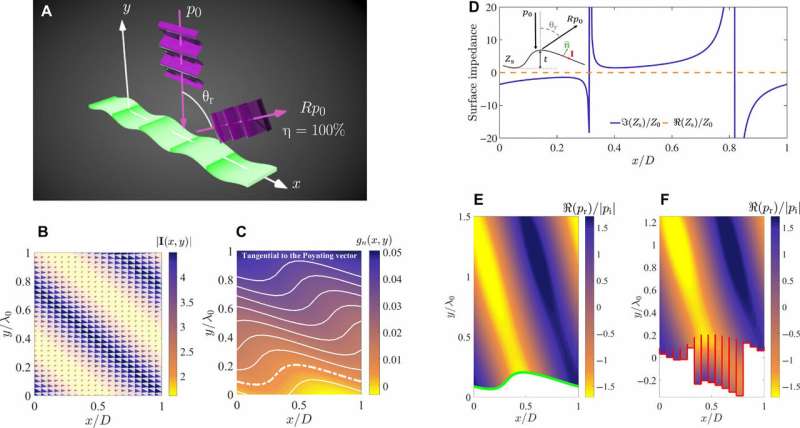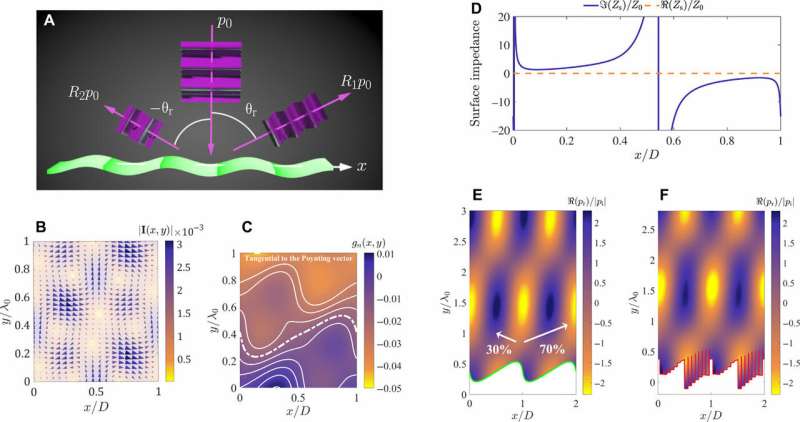February 22, 2019 feature
Engineering wave reflections with power flow-conformal metamirrors

Metasurfaces are two-dimensional (2-D) metamaterials that can control scattering waves of a light beam. include thin-sheet polarizers, beam splitters, beam steerers and lenses. These structures can control and transform impinging waves based on the (GSL; generalized Snell's law and generalized reflection law), which states that small elements can control the directions of the reflected and transmitted waves.
In a recent study, Ana Díaz-Rubio and co-workers in Finland and the U.S. investigated reflective metasurfaces known as metamirrors. The work was based on power flow distribution and the adaptation of the reflector shape to engineer the desired distributions of incident and reflected fields, resulting in highly efficient metamirrors. The work investigated anomalous reflection and beam splitting for both acoustic and electromagnetic waves, and the results are now published in Science Advances.
It was only recently that scientists understood the by metasurfaces. To understand the difficulties of controlling reflections from metasurfaces, scientists considered power flow in the vicinity of anomalous reflectors. For instance, in theory, there will be regions where the power carried by the incident and reflected waves of interest "enter" the metasurface and regions where power "emerges" from the surface. The phenomena indicated that metasurfaces required periodically distributed or strongly . To achieve this in practice, scientists can carefully engineer the surface resistance profile of materials for high-efficiency reflections in arbitrary directions.
Furthermore, two reflected waves can be simultaneously controlled to fully engineer wave reflections. had shown that the design of phase-gradient metasurfaces based on generalized reflection law—had higher efficiencies if the deflection angle did not exceed 40 to 45 degrees. To design highly efficient devices such as holograms or lenses, multiple reflected waves must be controlled without parasitic reflections. As a power-guiding mechanism, scientists have previously behind metasurfaces to realize non-local interactions between meta-atoms.

In the new study, Díaz-Rubio et al. studied the possibility of creating metamirrors capable of reflecting waves in arbitrary directions, without parasitic scattering and without the need for evanescent fields close to the metasurface. The scientists introduced a Multiphysics design method to create acoustic or electromagnetic metamirrors to shape the reflected waves. They described a systematic method to design theoretically perfect metamirrors based on an approach containing four steps, including:
- The definition of the fields for the desired function.
- Analysis of the power flow distribution and definition of the conformal surface.
- Surface impedance calculations
- Implementation with passive elements.
The scientists performed numerical simulations in the study using the finite element analysis of COMSOL Multiphysics software. The proposed designs were simulated and calculated using hard wall boundary conditions. The scientists simulated illumination as a perfect plane wave, implemented using background pressure field domain conditions.

The design approach introduced by Díaz-Rubio et al. did not require any numerical optimizations for physical insight into the complex reflection and diffraction phenomena. The study outcomes therefore provided a clear advantage for use in practical device design and development. As a proof-of-concept, the scientists conducted an experimental validation in the study, for which they chose acoustic metamirrors capable of reflecting normally incident acoustic waves into the 70 degrees direction. Díaz-Rubio et al. engineered the metamirrors using 3-D printed closed-end tubes, where the surface geometry followed the conformal contour perpendicular to the power flow direction as numerically simulated.
In the experiment, the scientists conducted measurements to obtain the scattered fields. The results showed that more energy traveled in the desired direction, while a residual amount of energy scattered in other directions. The observed imperfections were a consequence of the finite width of the beam; therefore, the performance of the metamirrors were better with wider beams. From this analysis, the scientists showed that the energy scattered in undesired directions could be markedly reduced when they increased the width of the beam in the experimental setup. In this way, Díaz-Rubio et al. showed higher efficiency of the conformal metamirror compared to the corresponding conventional design.
For experimental field mapping measurements with acoustic waves, the scientists used a loudspeaker array with 28 speakers to send a Gaussian-modulated beam to the metasurface and scan the field using a moving microphone at a step of 2 cm. They obtained the acoustic field at each spot, which they then calculated using the method. The acoustic fields measured at 3000 Hz were in excellent agreement with the simulations. When the scientists measured the efficiency of the metamirrors based on the scattered energy, they obtained a value at 96.9 percent, validating their approach.
The experimental validation reported in this study by Díaz-Rubio et al. is the first implementation of an anomalous reflective acoustic metamirror that could overcome the efficiency limits of the previous GSL-based designs. Scientists had previously used conformal metasurfaces to engineer cloaking devices, optical and acoustic illusions and lenses, where the of scattering or reflecting bodies. Comparatively, in the concept proposed by Díaz-Rubio et al. conformal metasurfaces adapted to the desired power distribution of the fields instead. As a result, the concept can be used to realize complex field transformations with high efficiency as experimentally demonstrated in the study and remains to be investigated in practice in the future.
More information: Ana Díaz-Rubio et al. Power flow–conformal metamirrors for engineering wave reflections, Science Advances (2019).
Controlling light, News Feature, October 2011,
N. Yu et al. Light Propagation with Phase Discontinuities: Generalized Laws of Reflection and Refraction, Science (2011).
Journal information: Science Advances , Science
© 2019 Science X Network


















